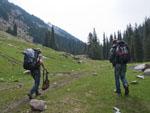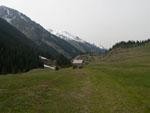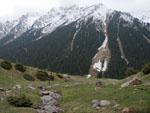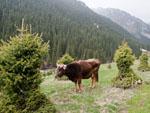We left Karakol intending to spend the day travelling to Sary Tash, a border town roughly 100km from the Kyrgyzstan/China border, a 950km route that we thought would take approximately twelve hours. We made a few poor judgments, first we left too late, at around 9am from Karakol, we then had trouble finding transport from Karakol, it was low-season, and nobody would go directly to Osh so we had to make do with hoping from one city to another. Another thing was we planned to cross on the Friday, the border was closed on weekends, and we couldn’t afford to lose another two days waiting for it to reopen.
Our initial transport was a marshrutka (Russian for ‘Fixed Route’), a small slow bus, that stops many times and doesn’t go above 60km/h. In three hours we reached the Barskoon junction, a measly 80kms from Karakol. We decided to hitchhike as there was no sign of public transport. Fortunately within ten minutes, two friendly young Kyrgyz men picked us up, who were making pharmaceutical deliveries around Lake Issyk Kol and were then heading back to Bishkek.
The Lonely Planet recommended taking transport from Balykchy, and then towards Naryn and onto Osh. However we further read that from October to June the Fergana Pass was closed, presumably due to snow cover, this meant we could no longer take the direct route through the centre of Kyrgyzstan and needed to go via Bishkek, an extra 200km journey. Fortunately, our drivers were going that way. We stopped for a lunch of traditional Kyrgyz dish beshbarmak (literally ‘five fingers’ as it is traditionally eaten by hand), it is a dish of noodles with lamb and a small slice of horse meat. It was the first time Sonya and I had eaten horse, the way it was cooked was quite spicy.
We reached Bishkek at around four o’clock and headed straight for a tour agency. During the ride we also happened to read that during May 1st to May 10th the border was closed due to a number of national holidays, we wanted to confirm if it would be open, we were informed that it was, but also reality struck that there wasn’t enough time to reach Sary Tash. We had done the Osh to Bishkek route previously and knew it took around eight hours in daylight. Osh to Sary Tash would a further three to four hours, then there was the time need to go from Sary Tash to the border, reaching for a planned 9am crossing. If we did attempt it, we would be cutting it extremely close, the driver would be driving all night and through two mountain passes, there was a lot of risk.
After much thought and great disappointment, we eventually decided to fly to Kashgar via Urumqi instead, it was a hard decision to make, but we believe we made the best choice for us. It was particularly painful knowing that if we had planned it a little better this may have worked out differently.
thydzikgooglemap(http://sonyaandtravis.com/maps/karakol-kyrgyzstan-to-kashgar-china.xml)




























































































































